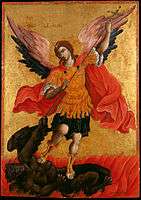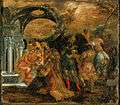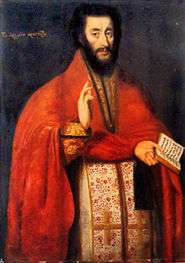Benaki Museum
|
| |
| Established | 1930 |
|---|---|
| Location | Athens, Greece |
| Website | The Benaki Museum |
The Benaki Museum, established and endowed in 1930 by Antonis Benakis in memory of his father Emmanuel Benakis, is housed in the Benakis family mansion in downtown Athens, Greece. The museum houses Greek works of art from the prehistorical to the modern times, an extensive collection of Asian art, hosts periodic exhibitions and maintains a state-of-the-art restoration and conservation workshop. Although the museum initially housed a collection that included Islamic art, Chinese porcelain and exhibits on toys, its 2000 re-opening led to the creation of satellite museums that focused on specific collections, allowing the main museum to focus on Greek culture over the span of the country's history.
Athens campus
_-_Google_Art_Project.jpg)
The museum's primary home is in the Benakis' house opposite the National Garden on Queen Sofias Avenue and owes its existence to the generosity of Antonis Benakis, whose family lived in Alexandria, Egypt.
In 1931, the Benakis donated the family's house in Athens and their collection of more than 37,000 Islamic and Byzantine objects. More than 9,000 artifacts were added by the 1970s, which spurred donations from other sources.[1] Benakis remained active in the museum until his death in 1954.[2]
Under the directorship of Angelos Delivorrias, the museum added more than 60,000 objects, books and documents, some of which were purchased and others donated. Delivorrias opts to focus on displaying donated items in order to encourage public participation and strengthen the community's ties to the museum.[1] The museum also focuses on the fact that Greek history does not begin and end with specific events but rather exists along a continuum that continues today.[3]
Parts of the museum's collections have travelled worldwide, including Canada in 2008,[4] the United States in 1959 in partnership with the Smithsonian Institution[5] and in 2005, an Ancient Greek solid gold drinking cup left Greece for the first time and traveled to the Powerhouse Museum in Sydney and the Melbourne Immigration Museum in Melbourne, Australia.[6]
2000 re-opening
In 2000, the Benaki Museum reopened following a $20 million renovation and restoration of the building, which had been damaged in an earthquake.[3] The renovation allowed it to become the only museum in Greece that brings visitors through all ages of Greek culture and history. It is also unique in that it does not focus on nationalism but rather recognizes and celebrates the foreign influences on Greek culture.[1]
Although the museum's director, Angelos Delivorrias, came up with the idea to refocus the museum and its exhibits in 1973, more than 25 years passed before he was able to make this a new reality. This reality involved moving the museum's collections of Islamic Art and Chinese porcelain with painting to other locations so that the main museum in Athens would focus solely on Greece.[1]
Satellite museums
Over the years the museum has been further endowed by various donors, and it now includes the seaside Kouloura Mansion in Palaio Phaliro, which is to house a Children's Toys Collection, the Benaki Islamic Art Museum in the Kerameikos district, the Nikos Hadjikyriakos-Ghikas Museum in downtown Athens, and the Penelope Delta House in Kifissia, which houses the Historical Archive Collection.
Benaki Islamic Art Museum
As part of the museum's re-focusing on Greek culture, its Islamic collection was moved to a new home in 2004 in time for the Athens Olympics. The new museum also has new galleries for temporary traveling exhibits.[7]
Inaugurated on 27 July 2004, the museum occupies more than 1,000 square meters of remodeled space showcasing: ceramics, pottery, metalwork, gold, woodcarvings, glasswork and textiles, bone carvings, inscribed funerary steles, arms and armor. The museum's collection is said to rank among the most important worldwide and includes masterpieces from India, Persia, Mesopotamia, the Middle East, Arabia, Egypt, North Africa, Sicily, Spain and Asia Minor. Covering Islamic art from the 7th through the 19th centuries, it has a rich collection of Ottoman art from the Empire's peak in the 16th century.[8]
Gallery
-

St Spyridon and scenes from his life by Theodoros Poulakis
-

Archangel Michael by Theodoros Poulakis
-

Adoration of the Magi by Ioannis Permeniatis
-

Adoration of the Magi by El Greco
-
_02.jpg)
Pieta by El Greco, 1566
-

St.Mark the Evangelist by Emmanuel Tzanes, 1657
-

Four military saints by Michael Damaskenos
-

Greek priest by Nikolaos Kantounis
-

The Sacred Band in Draghasani by Peter von Hess
-

Henry Pickersgill: Greek maiden, 1829
-

Dionysios Solomos, unknown artist
-

Death of Markos Botsaris by Marsigli Filippo
-

Old man wearing a red fez by Nikolaos Gyzis
-

Mitre of 1715
See also
References
- 1 2 3 4 Dina Kyriakidou (2000-07-22). "New Museum Celebrates Greece Through the Ages". The Globe and Mail. Retrieved 2008-05-29.
- ↑ "A Museum with a Point of View". The New York Times. 1981-12-27. Retrieved 2008-05-29.
- 1 2 Frederika Randall (2000-05-26). "Reopened Benaki Museum Shows Seven Millennia of Greek Art Treasures". The Wall Street Journal. Retrieved 2008-05-29.
- ↑ Paul Gessell (2008-05-24). "Greeks Bearing Gifts". The Ottawa Citizen. Retrieved 2008-05-29.
- ↑ "Greek Costumes on Display Here". The New York Times. 1959-10-25. Retrieved 2008-05-29.
- ↑ "A Cup Commeth". The Age. 2005-09-27. Retrieved 2008-05-29.
- ↑ Victoria Kyriakopoulous (2004-08-08). "Athens Shows off its Olympic Face-lift". The San Francisco Chronicle. Retrieved 2008-05-29.
- ↑ Mona Khazindar (2005-01-08). "Islamic Arts in Athens". Arab News. Retrieved 2008-05-29.
Further reading
- Sabetai, Victoria. (2006) Corpus Vasorum Antiquorum. Greece, Athens, Benaki Museum. Athens: Research Centre for Antiquity of the Academy of Athens. ISBN 9789604041015
External links
| Wikimedia Commons has media related to Benaki Museum. |
- The Benaki Museum
- Benaki Collection Postbyzantine ecclesiastical works
- Benaki Museum - Ebook by Latsis Foundation
Coordinates: 37°58′33.38″N 23°44′25.47″E / 37.9759389°N 23.7404083°E